new posts in all blogs
Viewing: Blog Posts Tagged with: IDEAS, Most Recent at Top [Help]
Results 26 - 50 of 338
How to use this Page
You are viewing the most recent posts tagged with the words: IDEAS in the JacketFlap blog reader. What is a tag? Think of a tag as a keyword or category label. Tags can both help you find posts on JacketFlap.com as well as provide an easy way for you to "remember" and classify posts for later recall. Try adding a tag yourself by clicking "Add a tag" below a post's header. Scroll down through the list of Recent Posts in the left column and click on a post title that sounds interesting. You can view all posts from a specific blog by clicking the Blog name in the right column, or you can click a 'More Posts from this Blog' link in any individual post.

“As a German citizen who came to the United States relatively late in life, I was initially struck by how much more positive thinking was valued in the United States than back in Europe.” Research psychologist Gabriele Oettingen had presumed this was a good thing – until she started doing some studies. It seems that some kinds of positive thinking are a lot less helpful than others.

“France’s leadership is struggling to pay for the government it provides. While the capital remains a global magnet of culture, it increasingly risks becoming a playground for the world’s elite, detached from its midsize cities, villages and countryside, where rising hardships stoke resentments and widen the opening for far-right parties.”

“Janet Vertesi tried hide her pregnancy from the Internet. She detailed her efforts to mask any behavior that suggested the coming change in her life, using everything from Tor to mask her browsing history to paying cash for gift cards to avoid using her credit cards.”

“In many cases, incompetence does not leave people disoriented, perplexed, or cautious. Instead, the incompetent are often blessed with an inappropriate confidence, buoyed by something that feels to them like knowledge.” (And every one of us is incompetent at something.)

By: yesisedit,
on 10/17/2014
Blog:
Yesisedit's Weblog
(
Login to Add to MyJacketFlap)
JacketFlap tags:
Thank yous,
Stories and art,
Food shortages a boom!,
Say it ain't so,
1,
childrens poems,
bail out,
Fair-e-tale,
Words can be funny,
illegal,
Fuel for thought,
Hati,
My view,
The gulf of Mexico,
unlawful,
story,
Fun,
greed,
Thoughts,
Art,
politics,
nature,
science,
humor,
people,
Photography,
Ideas,
Poem,
Children's book,
world,
Ecology,
help,
insects,
society,
Add a tag
What’s on my mind?
Indigenous peoples and their worry about being over run by other populations I guess could sum it up.
I suppose if cougars, wolves, elephants and such learned to shoot guns or band together better they would kick out the human populations who have transgressed on their land but as people go I believe we need to understand the reason for others unlawfully entering areas already overpopulated.
Overpopulation where they come from, economic despair, greed, the making of money into a God and the lust for power over others seem to be good places to start .
Seems to me that as people from a planet with finite resources we need to try to make all places a good place to live so people want to stay where they are. Make everywhere a good place to be.
Sharing with others does not have to mean give away my happiness but it could mean helping you gain yours. I hope I can do that with more than one other and if we all did it for just two other people it would cure the problem in my mind at least.


.jpeg?picon=3304)
By: Leslie Ann Clark,
on 9/29/2014
Blog:
Leslie Ann Clark's Skye Blue Blog
(
Login to Add to MyJacketFlap)
JacketFlap tags:
art,
drawing,
ideas,
children's book,
beaver,
Bear,
kids book,
My Characters,
kids,
fun,
cartoons,
Add a tag
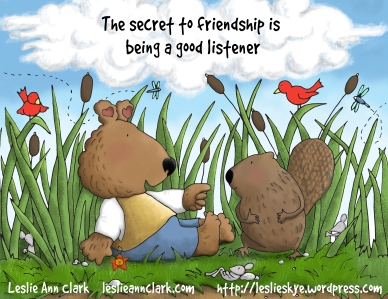
Do you ever have those days when nothing goes right? When everything you try does not work? That was my day today, accompanied by a doozer of a headache. Photoshop just quit on me. I could not open CS5 or CS6. Finally at the end of the day the Adobe Twitter Support came through! Hooray! It works!!
While I was waiting for support to write me back I was able to begin writing my stories for Burt ad Briley, my new characters. Their conversations made me smile. All’s well that ends well. I will post another picture soon.
Filed under:
My Characters 


By: yesisedit,
on 9/12/2014
Blog:
Yesisedit's Weblog
(
Login to Add to MyJacketFlap)
JacketFlap tags:
children,
Life,
story,
Photos,
friends,
Fun,
photo,
love,
birds,
Thoughts,
Art,
nature,
animals,
Photography,
Ideas,
Color,
Poem,
Children's book,
funny,
world,
help,
thought,
colorful,
society,
Stories and art,
Say it ain't so,
1,
look,
childrens poems,
Hap Murphy,
Fuel for thought,
My view,
Add a tag
When you are feeling all alone, if you just sing out loud you may be surprised how many others will join in with you …



By: yesisedit,
on 9/7/2014
Blog:
Yesisedit's Weblog
(
Login to Add to MyJacketFlap)
JacketFlap tags:
colorful,
Thank yous,
Stories and art,
Say it ain't so,
1,
look,
childrens poems,
political comment,
Hap Murphy,
Fuel for thought,
My view,
children,
Life,
story,
Photos,
friends,
Fun,
photo,
love,
flowers,
Thoughts,
Art,
politics,
nature,
animals,
Photography,
Ideas,
Color,
Poem,
Children's book,
world,
bugs,
Ecology,
thought,
Add a tag

I was just thinking that it’s not the perfect flower I look for in my photography, it’s the perfect feeling, same with my friends, they all have little flaws just like me but when I close my eyes and think of them I only know the sweet essence of their perfection and see how wonderful life is to let me see them … Love you all !


 You come up with a mind-blowingly awesome article idea: You’ve discovered some really cool thing, and you want to write about it.
You come up with a mind-blowingly awesome article idea: You’ve discovered some really cool thing, and you want to write about it.
For example, you’ve found out something fascinating about how train schedules are developed, or how makeup is made, or a unique museum, or a new business that’s just opened its doors.
So you have this amazing idea — why is everyone rejecting it?
This kind of idea is what I like to call an “Isn’t This Cool?” idea. You’ve found something neat, and you want to share it with the world.
But sadly, most publications don’t want to just share random interesting things with their readers. Each magazine has its own slant, and the product, fact, business or person you found needs to fit in with their mission.
For example, let’s take the idea of some weird aspect of how makeup is made. You want to send it to a women’s magazine, of course. What woman wouldn’t be interested in finding out this cool fact about how her mascara is made?
But women’s magazines are service publications, meaning most of their articles offer some kind of advice. So the editors wouldn’t be interested in this fact about makeup unless their readers can actually do something with it.
So if you have an idea where you think, “Isn’t this cool?” — ask yourself, “So what?” Why would readers care? How can you make them care? What can they do with it, or how can they apply the knowledge right now? For most publications, your ideas need to be useful and actionable.
For example, maybe women need to avoid makeup products that are made with this method, and you can round up the types of products this applies to so readers know which ones to look out for. That’s an idea you could pitch to a health magazine.
Or, let’s take the article you want to pitch on the Burnt Food Museum, and yes, this is real. (“Hey, this museum exists. Isn’t it cool?”) Rare is the magazine that would want you to just write about what a weird museum you found. It would do better as, say, a round-up of weird museums in New England readers can visit, complete with info on location, price, and hours. Now, readers can do something with that information.
Some magazines do run “Isn’t This Cool?” articles. For example, magazines for hobbyists love to run interesting facts about their hobby — how it developed, who’s doing interesting things with it, and why some aspects of the hobby are the way they are. Maybe a magazine for train enthusiasts would want to run an interesting fact on how train schedules are developed. And I once wrote an article about the world’s largest marble collection for a collectors’ magazine.
But for most markets, you’ll want to go beyond a cool fact. Dig until you figure out what makes this fact relevant to the readers of the pubs you want to pitch.
Sometimes, this means the idea you pitch will barely resemble the one you first thought of. And that’s okay! That’s how the idea process works. You get what I call the “seed” of an idea, and when you nurture it, it grows into something useful and beautiful that doesn’t look anything like the original seed.
How about you…do you have an “Isn’t That Cool?” idea you’ve tried to pitch? How do you think you can reslant it to be more salable? Let us know in the Comments below!
Artwork by Melva Medina
In the wake of a conversation about, well, just about everything, a son flagged up an article to me called "How to be Polite". It was excellent and funny and true. As I read, I thought "Yes! This is such good advice!" and then also "Yes! Politeness is the writer's friend!"
Listen, if you will, to this -
My ability to go to a party and speak to anyone about anything, to natter and ask questions, to turn the conversation relentlessly towards the speaker, meant that I was gathering huge amounts of information about other people.
Here’s a polite person’s trick, one that has never failed me. I will share it with you because I like and respect you, and it is clear to me that you’ll know how to apply it wisely: When you are at a party and are thrust into conversation with someone, see how long you can hold off before talking about what they do for a living. And when that painful lull arrives, be the master of it. I have come to revel in that agonizing first pause, because I know that I can push a conversation through. Just ask the other person what they do, and right after they tell you, say: “Wow. That sounds hard.”
Because nearly everyone in the world believes their job to be difficult. I once went to a party and met a very beautiful woman whose job was to help celebrities wear Harry Winston jewelry. I could tell that she was disappointed to be introduced to this rumpled giant in an off-brand shirt, but when I told her that her job sounded difficult to me she brightened and spoke for 30 straight minutes about sapphires and Jessica Simpson. She kept touching me as she talked. I forgave her for that. I didn’t reveal a single detail about myself, including my name. Eventually someone pulled me back into the party. The celebrity jewelry coordinator smiled and grabbed my hand and said, “I like you!” She seemed so relieved to have unburdened herself. I counted it as a great accomplishment. Maybe a hundred times since I’ve said, “wow, that sounds hard” to a stranger, always to great effect. I stay home with my kids and have no life left to me, so take this party trick, my gift to you.
A friend and I came up with a game called Raconteur. You pair up with another Raconteur at a party and talk to everyone you can. You score points by getting people to disclose something about their lives. If you dominate the conversation, you lose a point.
And you lose a chance. As a person and as a writer.
The next time you're asked where you get your ideas, try answering, "By being polite."
P.S. Please don't jump on me because you think I'm implying politeness is nothing more than a cynical tool for doing your job. I'm not. And really, I'd much rather hear about you ...
By:
Gi Hallmark,
on 6/29/2014
Blog:
The Children's Book Review
(
Login to Add to MyJacketFlap)
JacketFlap tags:
Mindfulness,
Social Graces,
Compendium,
Artful Illustrations,
Kobi Yamada,
Mae Besom,
Ages 4-8,
Creativity,
Picture Books,
Inspiration,
Ideas,
Gift Books,
Encouragement,
Add a tag
What Do You Do With An Idea? is about a boy who has an idea, illustrated as a golden crowned egg with legs. The boy wonders about the peculiar golden biped; its origins, its purpose, its place in the world.
 In the Premium version of my Write for Magazines e-course, I critique three article ideas from each student.
In the Premium version of my Write for Magazines e-course, I critique three article ideas from each student.
I’ll take an idea that’s almost-but-not-quite there (which is almost every idea) and show the student how to play with it, how to experiment with different angles until it’s just right to pitch.
And you know the response I often get?
“Since you didn’t like that idea, here’s another one.”
No, no, no!
Article ideas rarely pop out of a writer’s head fully-formed and ready to pitch. Even someone with 17 years’ experience (ahem) comes out with what I call SEEDS of ideas. A seed is the most basic form of an idea before you nurture it into a fully grown, salable article idea.
When you brainstorm, generate as many ideas as you can without judging them. Then, go through them one by one and start playing with the topics, angles, and markets to turn seeds into fully realized ideas. Like so:
If your idea isn’t newsy enough:
Here are three tactics you can try:
- See if you can find a recently-released book on the topic, or one that will be coming out around the same time you’re aiming your article for. (Search on Amazon.com and sort results by Date Published instead of Relevance.)
- Search for stats showing that what you’re pitching is a trend, or is becoming a trend.
- Figure out if there’s some way you can attach your idea to something that IS going on in the news. Maybe a celebrity just announced that she has some rare disease you wanted to write about, or you want to write on a marketing topic and a big business made the news with a major marketing fail.
If your idea is too narrow:
Consider finding three or more similar things and pitching them as a roundup. For example, instead of pitching an article on an historic attraction in your area, find four cool historic attractions and offer a roundup to a regional magazine.
Or, bring in other, similar but distinct topics. Instead of writing a pet health article only for ferret owners, expand it to include cats and dogs and pitch it to a general pets magazine or one of the women’s or health magazines that have pet departments.
If your idea is too broad:
Take one thin slice of the idea and blow it up to feature-size. For example, every health writer is pitching about the GMO issue, and frankly, this idea is big enough to fill a book. Is there some small aspect of the topic that hasn’t gotten much press, that readers may not already know about?
If your idea isn’t relevant to enough of your target market’s audience:
Is there a magazine or online publication that caters to an audience to whom your idea WOULD be relevant? For example, if a certain autoimmune disease affects only 2% of women, it won’t be of interest to a women’s magazine. But it WOULD be of interest to a magazine that targets people with autoimmune disorders. (And you’d be surprised at the publications you can find out there.)
If your idea is too vague:
Ask yourself, “What ABOUT topic X?” For instance, you want to write about job hunting for seniors. That’s pretty nebulous. What ABOUT job hunting for seniors? How to make your resume relevant for modern jobs, the top 10 best work-at-home jobs for seniors, how to volunteer your way into a paid job?
If your idea is just plain boring:
Consider: What’s the opposite of your idea? Editors love surprising, counterintuitive ideas that surprise readers and make them think.
Years ago I noticed that peanuts were getting a bad rap due to allergies (they had been recently kicked off of airplanes), so I pitched and sold an article called “In Defense of the Peanut” to Oxygen, about the health benefits of the beleaguered nut.
If your idea is about how to save money on groceries (been there, done that), you turn that into an idea on when it makes sense to spend more on food. (I did this for Fitness magazine, in an article called “Splurge or Save.”)
If your idea is on how to market your small business (snooooze), turn that into an article on how to attract customers without marketing.
So from now on, when your brainstorming session produces ideas you fear are stale, overdone, too narrow, or too big, don’t give up in despair. Remember, these are seeds of ideas, and you can nurture them until they grow into perfect pitches.
How about you: Did you recently come up with an idea you thought stunk? Can you apply some of the tips above to make it, well, not stink? Let’s play with your article ideas right here in the comments!
So Amy
wrote this. I agree with it wholeheartedly.
Then I
wrote this.
Then Amy extended the conversation
with this. Again, I agree with her wholeheartedly.
My post was chewing around the edges of something else that isn't quite as linear but is a huge piece of crediting people who create and citing them.
When I wrote about management perspective I was not referring to "management privilege". I detest anyone who poaches and claims credit or by omission leaves out the people who do the true heavy lifting. It's not how I try to run my shop or thankfully been managed by others - or most importantly -been treated by all my many colleagues around the state and country.
And I think that there is a great deal of professional pain that youth librarians feel from work they have not been credited for, celebrated for and appreciated for. I am definitely not arguing the great teamwork-kumbaya (we're all in this together, la-la).
I am coming at the discussion from one place as a long-time manager, a long-time active association member and a long-time consultant/presenter. And from the other place, I am coming as a newly energized researcher and teacher who demands citations and digging down to the original roots of work - most especially from myself! It is this perspective that I want to pursue.
As I have been studying the history of children's programming in public libraries, it is increasingly clear that youth librarians have been pushing the envelope of service since the beginning of the profession. Over the last century, children's librarians were at the forefront of developing SLPs, outreach, use of technology (radio, TV, films, filmstrips, record players), programming to parents (my mom was in the parent group while I was in storytime!), and many many of the practices that some in the profession are currently "inventing." Everything old IS new again.
There is a huge scaffold of practice upon which each and every one of us builds our own scaffold of service and innovative ideas. My concern is for some in the profession that don't want to recognize that foundation. Our foremothers and current colleagues have done work that we all build on - whether its oppositional building or complementary. When we don't acknowledge that debt - and appreciate where our own work is coming from, we do a huge disservice.
My point in my original post about how collaborative we are comes from that place. It is the "we" I am trying to get at.
So how do we acknowledge the "I" while being true to the "we" - and visa versa?
As Amy writes: cite!
Seek permission from those whose work your work is based on to share.
Communicate and don't steal.
Never false claim.
Know that your support of someone else's work enhances your own.
Acknowledge that the brainstorming power of coworkers, tweeps, Facebookers, a conference hallway conversation informed that idea that you brought to full fruition.
You cannot be harmed by acknowledging and citing. Rather you can be the power that raises up those around you. And that is a powerful "I" and a powerful "we".
 |
Slide from a solo Unprogramming presentation
that acknowledges my co-conspirator |
I laughed aloud when I saw AmyKoester's title on the
Storytime Underground post with guidelines on avoiding assholery when giving credit where credit is due. I also was happy to see such a strong statement about the importance of knowing and stating where stuff comes from.
I've
blogged about this before - especially in relation to the our penchant to be good sharing - and taking - people. You can't ever forget where something comes from and it is a beautiful thing when you can do that acknowledgement - most especially in a professional atmosphere (blogging, presentations, workshops, Twitter and Tumblr and etc). We all stand on the shoulders of those before us. We may tweak and we may tinker but somebody got that ball rolling.
I want to add another thought to the conversation - or throwdown from a management perspective: thinking about taking the "I" to "we."
I have always worked in a strong team environment. From the smallest library to larger libraries, many people - not just youth services staff - from director to Circ clerks to custodial staff have had a hand in contributing to conversation and idea-building. They have put in an oar, a thought, a suggestion, a brilliant solution that has made each and every project and program far better than it began.
I can count on one hand, ONE HAND, the actual stuff that I, me, myself, *I*, created, invented or totally birthed ON MY OWN in my 38 year career.
Uh-uh. Didn't happen. Dozens of things I am known for were the result of collaboration - free, wild, plunge-into-"what-if, what-if, what-if", brainstorming, tornadic, mosh pit, scrum-filled collaboration. When I've changed something, I am still building on something that went before that provided the ignition spark to push my own practice. Same goes for all of you, my friends and colleagues, out on the internet - you have shared and changed so many ideas that have helped me grow an idea and make it better. It's ours!
When you look at my blog posts as I am sharing a program, idea or innovation, you seldom see it written in the first person. Far more often, it is written as "we" and "our" because the progress or change or light bulb moment was built by many hands in the department and the library and out in my
ULN/PLN land..
While it is vital to credit your colleagues when you are sharing ideas that are clearly theirs and give them "mad props", it is also important to move away from the "I" and acknowledge the true "we-ness" of what is created through every-day and every-way collaboration.
I believe we are stronger together in everything we create. What do you think?
There’s been a lot of hiding around here lately.

A blog post about ME is hiding over at Peace, Love, and Whiskers. Pop over and check it out, if you haven’t already.

The other day, I saw this…
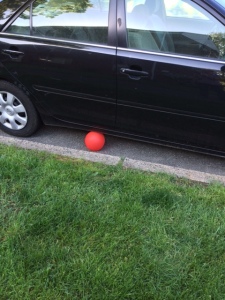
It’s an evil, runaway, red balloon. It’s hiding under the car, waiting to roll out and get me. Mom let me walk by really fast, because she knows that balloons are trying to kill me.

And look what’s back there! Two more balloons. White ones. I know what they have planned…

That’s close enough…
I have no plans to start liking balloons, but I want to thank my friend Little Binky for sending me this lovely award. I am not afraid of it.

Do you see what else is hiding? In the grass? A feather. It’s from the birds that sit in the trees and laugh at me.

All kinds of things are hiding in all kinds of places. When I try to hide, I always get caught. The other day, I brought my tiny yellow dog and hid on Mom’s bed with it. Somehow, she found out that I was in there.

I don’t know how she does it! She’s a regular Nancy Drew when it comes to figuring things out.
When she was little, Mom was probably Nancy Drew’s biggest fan. She read every one of the Nancy Drew Mysteries, and hung on every word.

Now that she’s a writer, she hardly ever writes mysteries. She wrote one once, and when it was finished, she said, “Ugh. This thing is so lame.” And “Where’s the suspense, the red herring, the foreshadowing!?” and “Seriously? You’re back on the bed again?”

Who? Me??
Mom might BE Nancy Drew, and LOVE Nancy Drew, but she has no plans to WRITE Nancy Drew.



By: Alice,
on 5/28/2014
Blog:
OUPblog
(
Login to Add to MyJacketFlap)
JacketFlap tags:
Books,
Economics,
ideas,
Current Affairs,
experience,
currie,
millennium development goals,
*Featured,
Business & Economics,
dfid,
tearing,
NGOs,
Bruce Currie-Alder,
Common problems,
development studies,
Foreign problems,
International Development,
Prospects,
Sovereign problems,
alder,
development”,
development’,
Add a tag
By Bruce Currie-Alder
Is thinking on international development pulling itself together or tearing itself apart? The phrase ‘international development’ can be problematic, embracing multiple meanings to those inside the business, but often meaningless to those outside of it.
On the surface, the Millennium Development Goals and debates towards a post-2015 agenda imply a move towards consensus. The past 60 years saw the development agenda embrace political independence, economic growth, human needs, sustainability, poverty reduction, and human capabilities. Each represented a particular understanding of what constitutes “development” and how to achieve it. Once dominated by economics and political science, the ideas and concepts used to explain development now draw on insights from across the natural and social sciences. Beyond academic debate, such ideas motivate real-life organizations and practitioners and shape their actions.

A female doctor with the International Medical Corps examines a woman patient at a mobile health clinic in Pakistan. Photo by DFID/Russell Watkins; UK Department for International Development. CC BY 2.0 via DFID Flickr
After interacting with over 90 writers over three years, I am convinced that thinking on development is tearing apart. Contemporary thinking comes from an increasingly diverse set of locations, with Beijing, New Delhi, and Rio de Janeiro challenging and enriching the ideas emanating from London, New York, and Paris. The rise of regional powers and localized approaches to development are reshaping our understanding of how human societies change over time. Fundamentally, the policy space for “international development” is tearing into three separate dialogues.
Sovereign problems concern the use of national wealth. All polities face real constraints in public finance and our societies face analogous challenges, such as: expanding access to and improving the quality of education and health, designing social protection to ensure a minimum wellbeing for everyone, or encouraging opportunities for entrepreneurs and minorities. Dialogue and action on sovereign problems involve national treasuries, political parties, and (mis)informed citizens. One can be inspired by experience abroad, but solutions must be tailored to fit within local cultural, political, and economic reality. This aspect of international development is growing.
Common problems concern international public goods. A sizable portion of our problems spill across borders and potential solutions require cooperation among different polities. Climate change, emergent diseases, and trade regimes surpass the ability of any one country and are affected by the choices made by others (indeed the nation-state is seldom the most useful unit of analysis). Common problems involve separate actors, ranging from municipalities and hospitals, to trade negotiators and the alphabet soup of international forums (IPCC, WHO, IFIs). After the rise of globalization, this aspect of international development is holding steady given the reality of a multi-polar world.
Foreign problems concern how to respond to troubled places abroad. Six decades of development saw substantial increases in life expectancy, human rights, and literacy. Yet there remains a stubborn set of poverty hotspots, ungoverned spaces, and fragile states where life continues to be nasty, brutish, and short. Dialogue and action involve foreign ministries, aid agencies, and NGOs. There are encouraging signs that this aspect of international development is in decline. The long-term trend witnessed a decrease in inter-state conflict and a dwindling list of low-income countries reliant on foreign aid. As such, the agenda is narrowing towards humanitarian relief, rural development, and state-building in remote locations.
This triad of sovereign-common-foreign offers one potential typology for the future evolution of thinking currently gathered under “international development”. Put more simply, when world leaders meet, the problems they discuss fit into the categories of mine-ours-theirs: those involving dialogue at home, those that require coordinated action across borders, and those related to hotspots beyond our borders.
In short, the label of “international development” has outlived its usefulness and is tearing apart in both academics and practice. For example, in the United Kingdom there is a tension between “development studies” focused on low-and-middle income countries, and “development sciences” applying technology to the needs of the poor. Meanwhile the range of organizations that engage in development has expanded, diversified, and coalesced into specialized communities. Once the exclusive purview of aid agencies and international organizations, there is an increasingly role for national treasuries, domestic charities, and diasporas in addressing different problems.
Looking forward, it seems likely that what is described as “international development” is destined to become a historic juncture, describing a period when we jumbled things together differently.
Bruce Currie-Alder is Regional Director, based in Cairo, with Canada’s International Development Research Centre (IDRC). He is an expert in natural resource management, and on the policies that govern public research funding and scientific cooperation with developing countries. His previous experience includes facilitating corporate strategy, contributing to Canada’s foreign policy, and work in the Mexican oil industry. He co-edited International Development: Ideas, Experience and Prospects (Oxford 2014) which traces the evolution of thinking about international development over sixty years. Currie-Alder holds a Master’s in Natural Resource Management from Simon Fraser University and a PhD in Public Policy from Carleton University.
Subscribe to the OUPblog via email or RSS.
Subscribe to only business and economics articles on the OUPblog via email or RSS.
The post Pulling together or tearing apart appeared first on OUPblog.


By: Genevieve Petrillo,
on 5/26/2014
Blog:
Cupcake Speaks
(
Login to Add to MyJacketFlap)
JacketFlap tags:
dreams,
acceptance,
writing,
children's literature,
ideas,
picture book writing,
submitting,
quote,
inspirational quote,
Add a tag
Visualize this thing you want. See it, feel it, believe in it. Make your mental blueprint and begin. Robert Collier
 Visualizing is an important part of a writer’s journey. Mom always visualized opening a letter of acceptance. She walked herself through every bit of how it would feel. The envelope – the weight of it, the uncertainty – that wiggly feeling in the tummy, the zipping it open – the rough edges, and the finally knowing – somebody said yes. Over and over for years and years, she saw it, felt it, and believed it.
Visualizing is an important part of a writer’s journey. Mom always visualized opening a letter of acceptance. She walked herself through every bit of how it would feel. The envelope – the weight of it, the uncertainty – that wiggly feeling in the tummy, the zipping it open – the rough edges, and the finally knowing – somebody said yes. Over and over for years and years, she saw it, felt it, and believed it.  But guess what. When her first story was sold, no letter came. Her publisher called her on the phone and left a message!
But guess what. When her first story was sold, no letter came. Her publisher called her on the phone and left a message!  That being said, Mom still visualizes getting an acceptance letter. Over and over. Every detail. Every single day. She says, “This will happen.” and “It can’t hurt.” and “What is going on in that tiny brain of yours?”
That being said, Mom still visualizes getting an acceptance letter. Over and over. Every detail. Every single day. She says, “This will happen.” and “It can’t hurt.” and “What is going on in that tiny brain of yours?”

What time is dinner?
I visualize, too, of course.

What time is dinner?
I see and feel and believe in tons of treats, piles of toys, 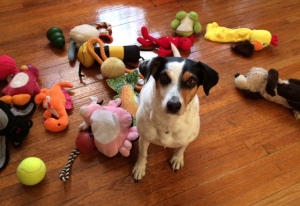 long walks, and playtime that never ends.
long walks, and playtime that never ends.  My mental blueprint shows how I will get onto the table, into the garbage, out the window, and through the door.
My mental blueprint shows how I will get onto the table, into the garbage, out the window, and through the door.  My brain may be tiny, but it’s busy all the time. Visualizing…..
My brain may be tiny, but it’s busy all the time. Visualizing…..

What time is dinner?


Mom likes sharing. She shares her stories with kids of all ages, every time she goes to an author visit.

She also shares her new stories with agents and editors . Sometimes she shares poems and ideas with her friends.
Whenever my friend Lila comes to see me, I share my toys with her  and she shares her mom with me.
and she shares her mom with me.  Whenever we visit the veterans’ home, Mom shares me with the old soldiers who miss their old pets.
Whenever we visit the veterans’ home, Mom shares me with the old soldiers who miss their old pets. 
And Mom even shares me with the kids at the library when we work at Read-to-a-Pet-Night.

Who wants to read me a story?
On Sundays, Mom sends my picture in to the local weather lady, who shares it with the viewing audience for Big Dog Sunday on TV.
Every Wednesday night, Mom helps me take an #idolselfie to send in to American Idol.
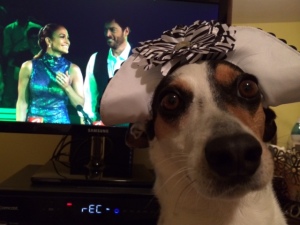
JLo, Harry, and me! #idolselfie
She thinks it’s time to share me with a bigger audience. They haven’t put me on Idol so far, but we’re hopeful.

Book #1
If Mom ever gets the elusive Book #2 published, she will share with a bigger audience. Nothing, so far, but we’re hopeful.


I confess: I clip articles almost daily from printed newspapers and magazines delivered to my address.
(Home-delivered newspapers? How about THAT for dating myself?!)
Article-clipping is a Family Thing.My mother clipped. My sister still clips. My nieces and cousins do too.
Recipes. Advice columns. Interviews. Book reviews. Movie write-ups. Funny cartoons. Touching quotes.
Oh, and death notices and marriage announcements.
In other words, anything and everything that when sent says, “I saw this and I thought of you!”
I and my family’s current generation of women use – with great optimism, the U.S. Mails to share our clippings.
The younger generation sends link-bearing emails or attached scans.
For obvious reasons, many of the articles my family sends on to me pertain to writing, children's books and authors. Those clippings have a pile all their own, a pile I, the Happy Clipper add to often. I call it My Writer’s Pile and it’s totally separate from my Story Ideas Pile.
Sometimes when I’m clipping an article, or truthfully, unevenly tearing out a section of a page, I have no idea WHY.
The piece or item simply spoke to me and I think, “I bet I could use this someday.”
Sometimes, though, I know the recipient instantly– a fellow writer, a former student, a school class I’m about to visit, or even my TeachingAuthors readers.
Thinking Spring, I titled this post “A Writer's Potpourri of Clippings."
In checking the correct spelling and definitions, however – “a mixture of flowers, herbs, and spices that is usually kept in a jar and used for scent” and “a miscellaneous collection,” my eyes slipped down the page to discover the word’s 1749 origin – the French words - “pot pourri” for “rotten pot.”
Which got me thinking…
I often liken the writing process and that of growing a story (as well as a career) to the process inherent in maintaining a compost pile and its clippings.
Maybe magic of sorts is going on within My Writer’s Pile and I don’t even know it!
Toss the following three clippings into your Writer’s (Compost) Pile and see what happens.
FLORAL NAMES FOR BABIES
HAS BECOME A BLOSSOMING TREND
By Nara Schoenberg, Tribune Newspapers – March 4, 2014
 “Plant-based baby names for girls overall are on the rise, and 10 previously low-profile botanicals – Lily, Violet, Willow, Hazel, Ivy, Olive, Dahlia, Juniper and Azalea – have risen rapidly.
“Plant-based baby names for girls overall are on the rise, and 10 previously low-profile botanicals – Lily, Violet, Willow, Hazel, Ivy, Olive, Dahlia, Juniper and Azalea – have risen rapidly. These 10 fast-rising names were given to a total of 19,500 baby girls in 2012 – more babies than received the No. 3 girls’ name, Isabella (18,900), according to data from the Social Security Administration."
I sent the original of this article to Cousin Jane in New Jersey whose first-born granddaughter is named Violet – after - I scanned and filed the article on my computer’s Hard Drive.
FYI: apparently there’s no parallel botanical trend in naming boys although the nature name “Canyon” has had recent traction (No. 1,462).
Naming characters is any writer’s job!
(Photo courtesy of Morgue File/mirabbi249-37-0)
WRITTEN IN INK
An eclectic blog uncovers the tales behind strangers’ tattoos
By Lauren Morrow, O Magazine - April, 2013
 I loved reading about and visiting illustrator Wendy MacNaughton’s and writer Isaac Fitzgerald’s blog Pen & Ink which reveals “the often hilarious, sometimes poignant stories behind these permanent remnants of our fleeting opinions, passions, and phases.”
I loved reading about and visiting illustrator Wendy MacNaughton’s and writer Isaac Fitzgerald’s blog Pen & Ink which reveals “the often hilarious, sometimes poignant stories behind these permanent remnants of our fleeting opinions, passions, and phases.”Apparently I wasn’t alone.
I haven’t used the idea or passed it on – ’til now.
Don’t you wonder sometimes, when you see an inked dolphin peeking out above a neighbor’s collar, “Why a dolphin?”
Or just what tattoo you might choose, if you haven’t already, and you want to break loose?
A character’s tattoos are a great way to come at knowing your Hero and knowing your Villain.
MIXED-MEDIA MAVENS
Artists’ book celebrates the
freedom and craft of art journaling
By Heather Schroering, Tribune Newspapers – April 20, 2014
Another two-partner idea – this time by Jenny Heid and Aaron Nieradka: scrapbooking with more layers and textures.
 When speaking to Young Authors, I advocate Journaling every chance I get.
When speaking to Young Authors, I advocate Journaling every chance I get.I liked the fun idea this article suggested of adding Ephemera – such as handwritten letters, maps, vintage photos, fabric, movie and concert tickets, old game pieces, you-name-it.
I bet kids would like it too!
And instantly they’d SEE the value of concrete details.
I also think it’s yet another way for writers, young and old, to come at knowing their characters – and that’s why I scanned this article and emailed it to two of my writers.
For the record, and though a Luddite at heart,
I do actually read newspapers, journals and magazines online daily and find myself more and more (sigh) cutting-and-pasting, copying and/or scanning and emailing myself links to fascinating articles.
I hate to waste an interesting idea!
Esther Hershenhorn

Game theory must be the epitome of Western faith in logic. We think that if we plug in some variables and press a button we can predict the future. Apparently, we apply it to all sorts of things: economics, war… It’s founded on our belief that if we know enough facts we’ll be in control. But do we really think that we can ever come close to factoring everything in? Isn’t it a bit like trying to predict exactly how the flap of a butterfly’s wings in Tokyo will affect the time that Mrs Morgan arrives at work in Sheffield?
And yet, perhaps those game theorists have a point. If, as quantum physicists now seem to believe, "we are one", the flap of a butterfly’s wings
will affect the time that Mrs Morgan gets to work. Nothing acts in isolation. Every event, every movement, every action, every thought is affected by everything that has come before it and in turn affects everything that comes afterwards. So there is, in fact, a formula connecting Tokyo and Sheffield – and if we could plug in every variable we could calculate the outcome.
In order to predict such complex causality with any certainty, however, our equation would have to take
everything into account. The result would be that it wouldn’t just predict one outcome, it would predict
every outcome. It would be huge. It would be a mathematical equation that would incorporate the entire world. No - the universe! Wait a minute – this equation would
be the universe. Our primitive little left brains, which like to quantify and categorize, simply aren’t sophisticated enough for this sort of maths.
Our right brains, however, would seem to be designed to compute exactly this sort of all-encompassing complexity. Not logically – but intuitively. In the creative and scientific disciplines, tiny portions of the Great Equation tend to reveal themselves in brief, bright flashes of insight, during which we shout ‘eureka!’ In fact, David Bohm, quantum physicist and author of
On Creativity, believes that the intrinsic appeal of all artistic or creative endeavour is this moment of satisfaction, in which we perceive what he describes as ‘a certain oneness and totality or wholeness, constituting a kind of harmony that is felt to be beautiful’.
The truth, in other words.
Writing fiction involves exactly these sorts of flashes of insight. They’re like lightning strikes, illuminating the way. Flash by flash we find our way through the forest, and step by step the narrative unfolds. Every step must link logically – truthfully – to the one before it and the one that comes after it. One false note and the chain is broken and the mathematics goes awry.
If we try and predict a plot logically, using a pre-arranged formula – the way that game theory seems to – it tends to feel ‘wrong’. It never quite rings true in a way that makes you want to shout ‘eureka!’ What a novelist wants is for the causality of events to be so sophisticated and yet so flawlessly logical that afterwards the reader thinks, “I didn’t see that coming – but in retrospect, of-course it was inevitable.” This sort of integrity is rarely achieved by the logical mind; it has to be intuited.
So, step by step we intuit the way. We draw on all the powers of our unconscious to intuit exactly what a certain character will do and what will happen as a consequence. Intuition is about widening our perspective, holding the whole world of our novel in the periphery of our vision in order to feel the pattern.
The end result is a plot: a linked sequence of cause and effect that has an almost scientific integrity to it. The plot reveals the underlying pattern, the mathematical formula that underpins our novel’s ‘reality’. How do we know if we’ve got it right? Because it feels right. It clicks.
Sometimes people assume that writing fiction must be easier than non-fiction. They assume that because you can make it up as you go along, you can write whatever you want. But nothing could be further from the truth. You can’t just write whatever you want. You have to write exactly what
would happen. No wonder writing fiction is so difficult. We are trying to predict the future.
www.heatherdyer.co.uk

By: yesisedit,
on 5/2/2014
Blog:
Yesisedit's Weblog
(
Login to Add to MyJacketFlap)
JacketFlap tags:
Children's book,
Future,
funny,
world,
Ecology,
hare,
help,
society,
Stories and art,
Say it ain't so,
1,
look,
childrens poems,
bail out,
Fair-e-tale,
Words can be funny,
Fuel for thought,
My view,
love,
play,
time,
thought,
rabbit,
Murphy,
native,
weed,
political comment,
ownership,
children,
Life,
story,
Fun,
greed,
Thoughts,
Art,
drawing,
politics,
nature,
science,
animals,
humor,
Ideas,
indigenous,
Add a tag
A quite lively discussion has blown in from space on a friends Face-postcard about something I forgot because it went a completely different way in short order and is now a history lesson on indigenous peoples.
It was said the “Native “”American”” people” were here first and that they claim to be “Indigenous” and that they have their traditional stories to back up their claim to properties etc.
That got me to thinking (usually leads to minor disasters) that just because someone in your past lived some place and told creation stories doesn’t always mean you have any more rights than the guy who was born there after you lost the battle, in my case way after.
I know, growing up, my mother used to tell me, when I asked how I got here that I came from heaven and perhaps, if I’m a good boy, God will give me land there again though I think he may balk at the casino I want to build even if it is to take all the sinner’s money or credits or what ever the currency of his realm is.
And further more if in the past there was only one super continent, Pangaea or what ever they really called it, then we all have a claim to everywhere cause we are all descendants of the original inhabitants and I’ll bet a dollar to a doughnut there aint anywho who can tell me where they thought they came from even after the break up.
I thought perhaps we are all from Mars via the Pleiades star system but had to leave cause the Marshonians wanted the place back so we moved on as they had come from the Hercules system to Mars first.
To send every one back to where they came from is stupid, you can’t fit that many people on Ellis Island let alone grow enough hemp there to have a trade economy with New York.
I don’t know the answer other than if we don’t start being natives from “EARTH” the little grey men will boot us out and wipe out the myths of our origins from then to eternity.
 It’s a race none us may win …
It’s a race none us may win …


Aerodynamically, the bumble bee shouldn’t be able to fly, but the bumble bee doesn’t know it so it goes on flying anyway.
Mary Kay Ash
I would like to fly. Sometimes, I fly around my house – from the floor to the bed and from the ottoman to the sofa and from the chair to the door.

But I’m not allowed to fly outside. If I could, I’d fly up into the trees to catch birds and squirrels.

They are up there laughing at me, so flying would come in handy to put a stop to that.
Mom writes picture books. But sometimes, she goes outside her comfort zone to write other things. Once she wrote a non-fiction story, but she hated it – ALMOST as much as she hated doing the research for it. She said, “This is too much like work.” and “I dread writing time.” and “You cannot climb a tree – you’re a dog, not a bear.”

Last weekend, Mom wrote a song. Her friend needed a little pre-k song for graduation, so Mom made it up and sang it out loud to herself over and over and over and over and over. She said, “That was easier than I thought.” and “I didn’t know I could write a song.” and “You cannot climb a tree – you’re a dog, not a bear.”
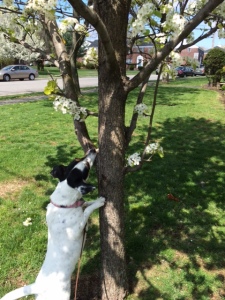
Sometimes we need to go out of our comfort zones and TRY to see what we really can do. Mom is no Paul McCartney, but she wrote a song. I may not be a bear, but if Mom would unclip my leash for 5 seconds, I think I can climb a tree. After all, bumblebees fly….



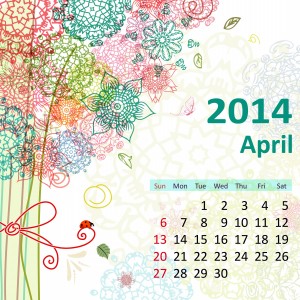
Spring is almost here. I mean it’s here on the calendar, but in real life, not so much. Mom and I look for flowers outside, but we’re not seeing a whole lot.
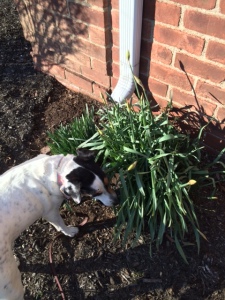
Almost there…not quite…
The grass is still kind of brownish and slime-ish in spots. And the wind still turns my ears upside down.

Also, the rain has Mom bringing out my raincoat every couple of days. April showers and all that….
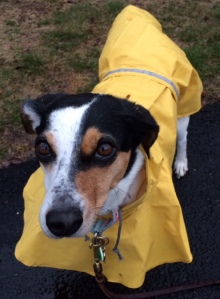
Real, actual spring – street nap spring – takes longer to happen, I guess.
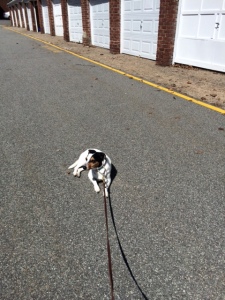
Chilly tummy.
Stories take longer than expected sometimes, too. The calendar says we’re 10 days into the month, but we’re not seeing much of Mom’s April manuscript. The idea is still brownish and slime-ish, and wind and rain in Mom’s head are slowing down the progress. Her ears aren’t upside down or anything, but I’m hearing an awful lot of “Here we go.” and not an awful lot of, “Yay. I’m finished.”
I think the rain wetting the soil and the wind flying the seeds all around are putting down the groundwork for the real season.

This is definitely a sign of spring…
Like the rain and the wind, mind-writing and planning are putting down the groundwork for Mom’s story. The daffodils are starting to pop. I hope Mom’s story will pop soon, too.
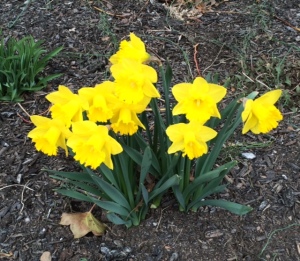


Spring is finally coming. Things that have been hidden under the snow are coming back. Look! It’s a coffee cup!

Mom’s new story was hidden under the snow in her brain. Every single day, when she started working on it, she gave it a new title, made a list of new characters, decided on a new theme, and gave them new goals to accomplish, new problems to solve, and different obstacles to overcome.

It’s a good thing spring is coming. Mom’s hidden story is coming back. It’s her third day working with the same title, the same theme, the same characters, and they have the same goals, problems, and obstacles as they had yesterday.

I think spring has sprung….
Look! It’s a banana!

I wonder if the black bananas taste better than the yellow ones….
And a ginger ale bottle.

And my beehive is back from under the snow!!
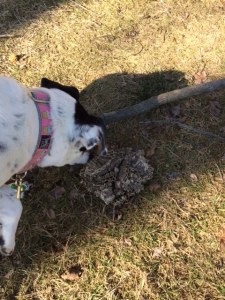
Hello, old friend…



By: Genevieve Petrillo,
on 3/1/2014
Blog:
Cupcake Speaks
(
Login to Add to MyJacketFlap)
JacketFlap tags:
kidlit,
reading,
poetry,
writing,
children's literature,
characters,
ideas,
dialogue,
rejection,
picture book writing,
inspirational quote,
12x12,
Add a tag

Today is Dr. Seuss’s birthday. He would’ve been 109 years old. He is the Best Doctor Ever on account of no needles, no looking into ears with a flashlight, no sticks stuck into forbidden places, and no touching of my bits and pieces.

Waiting for the Doctor. Hoping for the Best.
Mom also loves Dr. Seuss for a million other reasons – his wild imagination, his silly rhyming, his crazy stories, and the fact that his first book was rejected 27 times before anybody said they liked it. Misery loves company.

Mom’s #1 favorite Dr. Seuss book is The 500 Hats of Bartholomew Cubbins from 1938.

Normally, Mom and I steer clear of anything that smacks of numbers, but counting those hats is so much fun and so suspenseful that we can’t resist it. Also, a hundred years ago, Mom’s 5th grade teacher, Mrs. Nelson read that story to her class and Mom and her friends giggled and counted and were afraid for poor little Bartholomew not being able to take his hat off for the king.
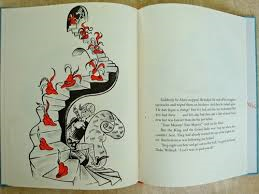
As of Dr. Seuss’s birthday, Mom is up to date on her 12×12 Challenge. She has written 2 new stories in the past 2 months. Now it’s a new month and time to start a new story.

In which direction should she go?
Direction? Up, of course.

King of the Hill of Filth
What will be original?
Original? It doesn’t get any more original than an old dog learning a new trick.

Who will step out of her list of character ideas?
Character? This one.

Or this one.

Or this one.

How will she make the story sparkle?
Sparkle? With a tiara, of course.

Am I sparkling, yet?


View Next 25 Posts

















































































Love the illustration, the message therein, and the mice !
I’m so sorry you had to go through all that. It’s so frustrating and scary when you cannot get to point B because Point A was mangled by a glitch or software program. It’s amazing to me that a story could still flow from you during the “waiting” period. I would probably be eating chocolate or shopping at thrift store, hahahaha.
Thank you Maureen. Are you home yet?
I have been practicing being peaceful and taking care of myself better. … uh… but I did slam a few doors. hahaha!